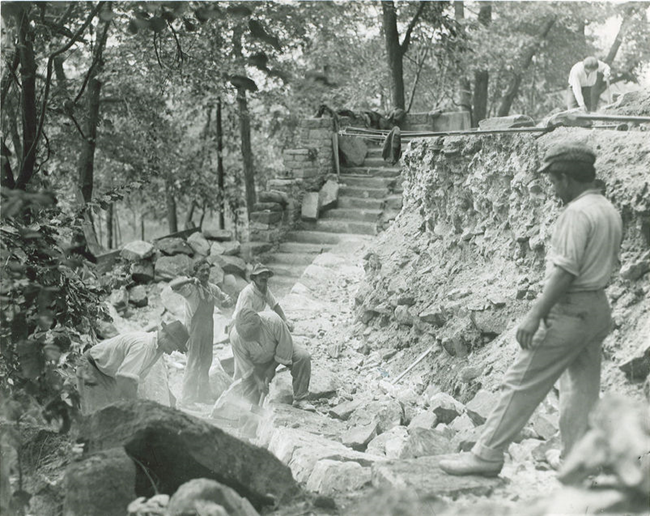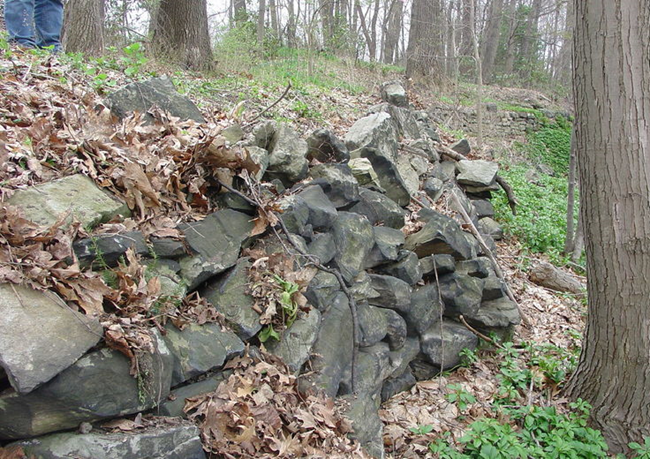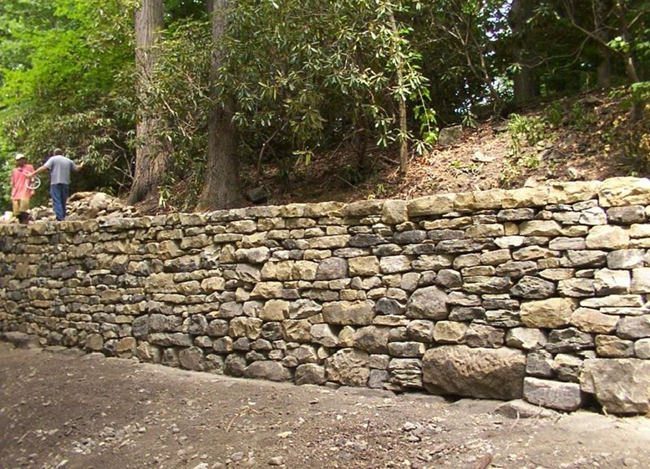Last updated: June 28, 2018
Article
Dry Stone Wall Restoration at Stan Hywet Hall, Ohio
Stone has been used throughout the world as a construction material in cultural landscapes, dating to prehistoric times. Examples of ancient dry stone construction traditions and craftsmanship include terraces in China and Peru, walls and shelters throughout the United Kingdom, and vast numbers of walls and fences here in the United States. The term dry stone refers to the technique of assembling stone structures without the use of mortar and relying on the forces of gravity and frictional resistance to create long-term durability. Although dry stone walls and buildings are perhaps the most common types of this ancient craft, other examples include mills, dams, canals, kilns, bridge abutments, railway piers and embankments.
In the United States, dry stone construction dates to the colonial period and was a common feature of agricultural, industrial and residential landscapes. Over time, these stone walls and structures, especially ubiquitous throughout New England and the Kentucky Bluegrass Region, started to disappear. Those that remained deteriorated through a combination of neglect, lack of maintenance, or outright destruction. Development, road widening projects, abandonment of farms fields, theft, and disassembling of the walls for various purposes all have led to a startling loss of stone walls and fences throughout the nation.
The Dry Stone Conservancy (DSC), based in Lexington, Kentucky, formed in 1996, preserves dry stone structures and promotes this venerable craft. A serious shortage of skilled dry stone masons, compounded by a scarcity of technical information, construction specifications, and engineering data led to the incorporation of the DSC as the national training center for training and expertise. The DSC provides six program areas that are not mutually exclusive: training and certification of dry stone masons; restoration and construction/training projects; local, state, and federal government and non-government agency collaboration; public education; research, publication, collections, and archives; and development (fundraising, financing, and grants). Of these six areas, the first two are specifically related to on-site construction and restoration of dry stone walls. DSC-led construction projects have occurred throughout the United States.
The Dry Stone Conservancy (DSC), based in Lexington, Kentucky, formed in 1996, preserves dry stone structures and promotes this venerable craft. A serious shortage of skilled dry stone masons, compounded by a scarcity of technical information, construction specifications, and engineering data led to the incorporation of the DSC as the national training center for training and expertise. The DSC provides six program areas that are not mutually exclusive: training and certification of dry stone masons; restoration and construction/training projects; local, state, and federal government and non-government agency collaboration; public education; research, publication, collections, and archives; and development (fundraising, financing, and grants). Of these six areas, the first two are specifically related to on-site construction and restoration of dry stone walls. DSC-led construction projects have occurred throughout the United States.

Photo courtesy of Stan Hywet Hall archives.

Photo courtesy of Dry Stone Conservancy.

Photo courtesy of Dry Stone Conservancy.
Following the completion of the wall restoration, workers cleared much of the accumulated brush, windfall, and expired vegetation along the lower slope, exposing much of the glacial-deposited stone slabs that Manning incorporated into his design for the wild garden setting. The contrast of the natural exposed stone and naturalistic plantings with the constructed dry stone feature is striking. This project, in concert with several others, has allowed Stan Hywet Hall & Gardens to reopen almost eight acres that had previously been inaccessible for public interpretation and enjoyment.
Many thanks to Mark Gilles, architect at Stan Hywet Hall, for contributing information about the restoration project.
For additional information regarding Stan Hywet Hall & Gardens, visit:
http://www.stanhywet.org/.
For additional information about the Dry Stone Conservancy, visit:
http://www.drystone.org/.
Originally published in "Exceptional Places" Vol. 3, 2008, a newsletter of the Division of Cultural Resources, Midwest Region. Written by Geoffrey Burt.
Many thanks to Mark Gilles, architect at Stan Hywet Hall, for contributing information about the restoration project.
For additional information regarding Stan Hywet Hall & Gardens, visit:
http://www.stanhywet.org/.
For additional information about the Dry Stone Conservancy, visit:
http://www.drystone.org/.
Originally published in "Exceptional Places" Vol. 3, 2008, a newsletter of the Division of Cultural Resources, Midwest Region. Written by Geoffrey Burt.
